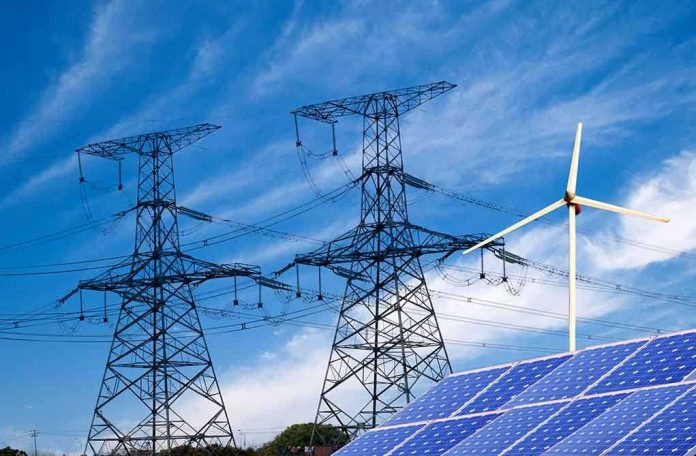🔴 Website 👉 https://u-s-news.com/
Telegram 👉 https://t.me/usnewscom_channel
California’s $2.2 billion Ivanpah Solar Power Plant—once the world’s largest—will begin shutting down, exposing deep cracks in the state’s green energy ambitions and leaving critics to question whether California’s renewable revolution was built on sand or sun.
Story Snapshot
- Ivanpah’s partial closure spotlights costly missteps in California’s renewable energy planning
- Financial, environmental, and technological struggles doomed the high-profile solar project
- Industry shift to cheaper photovoltaic solar renders Ivanpah obsolete
- Debate intensifies over the future of large-scale green initiatives in California
California’s Green Dream: Ivanpah as Crown Jewel and Canary
The Ivanpah Solar Power Plant opened in 2014 amid fanfare, touted as a testament to California’s leadership in clean energy. Strategically placed in the Mojave Desert near Primm, Nevada, Ivanpah harnessed an army of 173,500 heliostats—massive mirrors focusing sunlight onto three central towers—to generate steam and power turbines. The project’s $2.2 billion price tag was underwritten by federal loan guarantees and the backing of NRG Energy, BrightSource Energy, and Google. Ivanpah was more than a power plant; it was a symbol, a statement of intent, and a political trophy meant to vault California past competitors in the global race for renewable energy dominance.
Solar Plant Closure Is Latest Sign California’s Green Agenda Isn’t Working https://t.co/qLaePyiGVs
— James (@James7820543786) October 1, 2025
From day one, Ivanpah was burdened with outsized expectations. Its technology—concentrated solar power (CSP)—was billed as the next leap beyond traditional photovoltaics. California’s policy architects and utility companies signed long-term purchase agreements, betting Ivanpah would help meet aggressive renewable portfolio standards. Yet, reality rarely matched the hype. The plant delivered less electricity than projected, falling short of output targets year after year. Meanwhile, environmentalists quickly sounded alarms: Ivanpah’s intense heat and vast footprint were deadly to birds and disruptive to desert ecosystems. Public perception shifted as images of scorched avian casualties and disrupted habitats circulated, eroding the project’s green credentials.
Financial Fault Lines and Technological Turbulence
PG&E, one of California’s largest utilities and a major buyer of Ivanpah’s electricity, began signaling trouble in 2023. The utility initiated moves to restructure or terminate its contract, citing the high cost of Ivanpah’s power compared to plummeting prices for photovoltaic solar. By January 2025, Ivanpah’s owners and the Department of Energy agreed to terminate the contract. The plant’s fate was sealed: deactivation and decommissioning would begin in early 2026. Underperforming output, environmental controversy, and market forces converged to turn Ivanpah into a cautionary tale, not a model for emulation.
BrightSource’s innovative CSP technology proved less scalable than hoped. The rise of cheaper, more efficient PV solar panels—products that could be deployed on rooftops or in open fields for a fraction of Ivanpah’s cost—shifted industry momentum away from massive, centralized CSP facilities. Ivanpah’s sprawling infrastructure and fixed operations became liabilities, not assets, in a fast-evolving energy market. As the plant stumbled, other CSP projects faced similar struggles, prompting a broader industry reckoning about where the future of solar truly lay.
Stakeholders Scramble and Policy on Trial
Ivanpah’s closure reverberated across California’s energy landscape. Investors—NRG, BrightSource, and Google—faced financial losses and reputational hits. Utilities like PG&E and Southern California Edison scrambled to fill renewable power gaps, potentially passing costs onto ratepayers. Environmental groups, long divided over Ivanpah’s wildlife impacts, pressed for habitat restoration and more careful planning in future projects. Regulators and policymakers confronted uncomfortable questions: Were California’s renewable policies too quick to favor unproven, expensive technologies? Could better oversight or more adaptive planning have averted this costly outcome?
Political scrutiny intensified as critics labeled Ivanpah a “monument to ineptitude and government waste.” Supporters of California’s green agenda argued that technological evolution—sometimes messy, sometimes expensive—was a normal part of innovation. But for American conservatives and common sense observers, Ivanpah’s demise underscored the dangers of government-driven energy ventures that ignore market realities and environmental tradeoffs. The plant’s closure sharpened the debate over the role of public funding, regulatory mandates, and policy incentives in shaping—and sometimes distorting—the energy sector’s future.
Impacts, Lessons, and the Road Ahead
Ivanpah’s shutdown will reduce California’s renewable capacity, but the site may be repurposed for PV solar—a nod to the relentless march of market forces. Local communities must contend with economic shifts, while utility customers brace for potential rate hikes. Environmentalists hope decommissioning brings opportunities for repair and restoration, but memories of habitat disruption linger. In the broader industry, Ivanpah adds weight to the argument for rethinking large-scale projects, prioritizing proven technologies, and demanding rigorous project evaluation before billions are spent.
Experts point to Ivanpah as a turning point. Academic analyses highlight the plant’s ecological toll, while energy economists chart the market’s pivot to photovoltaic solar. Some see the closure as a warning: ambition without accountability can lead to spectacular—and costly—failures. Others maintain that innovation requires risk, and some projects must falter so others may succeed. All sides agree that California’s energy future hinges on lessons learned, not simply on ideals pursued. The Ivanpah story isn’t just about a plant—it’s about recalibrating a state’s green ambitions to align with technology, economics, and ecological reality.
Sources:
